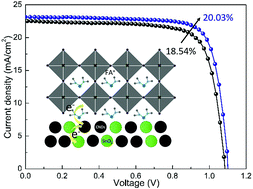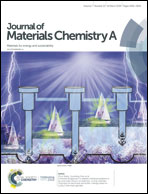Introduction of carbon nanodots into SnO2 electron transport layer for efficient and UV stable planar perovskite solar cells†
Abstract
SnO2 as an ideal electron transfer material for planar halide perovskite solar cells has recently attracted much attention. However, the planar structure device shows significant hysteresis behavior and low optical stability due to numerous trap states and high UV transmittance. Here, carbon nanodots (CNDs) obtained by hydrothermal synthesis were firstly introduced into SnO2 ETLs through a simple solution process. Ultraviolet photoelectron spectroscopy, electronic impedance spectroscopy and UV-vis spectroscopy were used to investigate whether the introduction of CNDs increases the electronic coupling as well as energy levers which contribute to efficient electron extraction. The results showed that the introduction of CNDs could reduce the trap-state density and increase the mobility in SnO2 films. Finally, the device based on the SnO2:CNDs ETLs reached a high power conversion efficiency (PCE) of over 20% and steady-state PCE of 19.83% with negligible hysteresis. The SnO2:CNDs device retained over 90% of the initial PCE after storage in dry conditions for 1200 h and exhibited better UV stability after exposure to UV illumination. These results verify the simple method for producing highly efficient and UV stable perovskite solar cells.

- This article is part of the themed collection: International Year of the Periodic Table : Low Dimensional Carbon Systems


 Please wait while we load your content...
Please wait while we load your content...